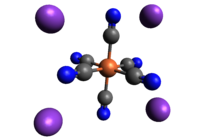
Back Kaliumheksasianoferraat(II) Afrikaans فروسيانيد البوتاسيوم Arabic پوتاسیوم فروسیانید AZB Ferrocianur de potassi Catalan Hexakyanoželeznatan draselný Czech Калий гексацианоферрачĕ(II) CV Kaliumhexacyanidoferrat(II) German Σιδηροκυανιούχο κάλιο Greek Kalia ferocianido Esperanto Ferrocianuro de potasio Spanish

| |

| |

| |
| Names | |
|---|---|
| IUPAC name
Potassium hexacyanidoferrate(II)
| |
| Other names | |
| Identifiers | |
| |
3D model (JSmol)
|
|
| ChemSpider | |
| ECHA InfoCard | 100.034.279 |
| EC Number |
|
| E number | E536 (acidity regulators, ...) |
PubChem CID
|
|
| UNII |
|
CompTox Dashboard (EPA)
|
|
| |
| |
| Properties | |
| K4[Fe(CN)6] | |
| Molar mass | 368.35 g/mol (anhydrous) 422.388 g/mol (trihydrate) |
| Appearance | Light yellow, crystalline granules |
| Density | 1.85 g/cm3 (trihydrate) |
| Boiling point | (decomposes) |
| trihydrate 28.9 g/100 mL (20 °C) | |
| Solubility | insoluble in ethanol, ether |
| −130.0·10−6 cm3/mol | |
| Hazards | |
| GHS labelling: | |

| |
| Warning | |
| H411 | |
| NFPA 704 (fire diamond) | |
| Flash point | Non-flammable |
| Lethal dose or concentration (LD, LC): | |
LD50 (median dose)
|
6400 mg/kg (oral, rat)[3] |
| Related compounds | |
Other anions
|
Potassium ferricyanide |
Other cations
|
Sodium ferrocyanide Prussian blue |
Except where otherwise noted, data are given for materials in their standard state (at 25 °C [77 °F], 100 kPa).
| |
Potassium hexacyanidoferrate(II) is the inorganic compound with formula K4[Fe(CN)6]·3H2O. It is the potassium salt of the coordination complex [Fe(CN)6]4−. This salt forms lemon-yellow monoclinic crystals.
- ^ Five Hundred Useful and Amusing Experiments in Chemistry, and in the Arts and Manufactures: With Observations on the Properties Employed, and Their Application to Useful Purposes. Thomas Tegg. 1825.
- ^ Cite error: The named reference
JTBakerwas invoked but never defined (see the help page). - ^ https://chem.nlm.nih.gov/chemidplus/rn/13943-58-3 [dead link]
